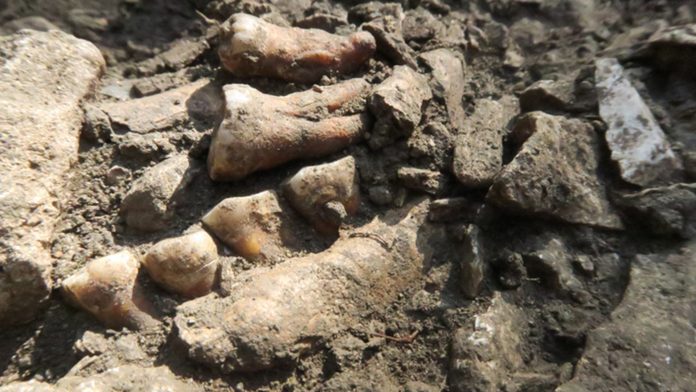Unearthed Secrets of Our Closest Relatives: Meet Thorin, the Neanderthal of a Lost Lineage!
In a remarkable discovery that could rewrite the chapters of human history, a lineage of Neanderthals, our closest relatives, has surfaced in a French cave system. Scientists have dubbed this find a world-first, shedding light on the ancient lives that roamed the earth.
In 2015, the fossilized remains of a Neanderthal, affectionately named Thorin after a character from *The Lord of the Rings*, were unearthed in the Rhône Valley. This wasn’t just another relic; it was the key to understanding a previously unknown community of Neanderthals.
Thorin: A Unique Window into Neanderthal Life
DNA analysis reveals that Thorin thrived between 42,000 and 50,000 years ago, part of a small yet distinct community that had been isolated from other Neanderthal populations for millennia. This groundbreaking find challenges the earlier notions that only a single, genetically homogeneous Neanderthal population existed before their extinction.
“Until now, the story has been that at the time of the extinction there was just one Neanderthal population that was genetically homogeneous, but now we know that there were at least two populations present at that time,” observes geneticist Tharsika Vimala.
The Neanderthal Discovery: What We Learned
Published in *Cell Genomics*, this research not only elevates our understanding of Neanderthals but also opens avenues for further investigation into their extinction. Interestingly, Thorin’s remains were found within the Grotte Mandrin, a cave known primarily for human habitation. Despite the discovery happening seven years ago, the excavation team continues its careful study of the site.
Remarkably, evidence indicates that Thorin lived only a short distance from another Neanderthal population, hinting at the fascinating dynamics of prehistoric life. “The Thorin population spent 50,000 years without exchanging genes with other Neanderthal populations,” co-first author Ludovic Slimak points out, emphasizing how these two groups existed in close proximity yet remained oblivious to one another.
The Unique Genetics of Thorin: Why It Matters
Senior author Martin Sikora believes Thorin’s genome is a remnant of some of the earliest Neanderthal populations in Europe. “The lineage leading to Thorin would have separated from the lineage leading to the other late Neanderthals around 105,000 years ago,” he explains.
From meticulous analysis of Thorin’s teeth and jaw, researchers have deduced he likely lived between 40,000 and 45,000 years ago, categorizing him as a “late Neanderthal.” Interestingly, initial findings even suggested that Thorin’s genetic makeup had a striking resemblance to Neanderthals from over 100,000 years ago. This connection hints at the broader complexities of Neanderthal migration and evolution across the continent.
Archaeological Insights: Life During the Ice Age
To further unravel the mystery surrounding Thorin, archaeologists conducted a seven-year investigation, using isotopic analysis of his bones and teeth. Isotopes, being atoms with variable neutron numbers, provide vital clues about prehistoric lifestyles, including diet and habitat.
This analysis suggested that Thorin experienced a frigid climate, typical of late Neanderthals living during the Ice Age. As earlier Neanderthals enjoyed warmer weather, this finding solidifies Thorin’s timeline in the icy realms of prehistoric Europe.
Understanding Neanderthal Extinction: A Cautionary Tale
Thorin’s genome suggests a connection to an unknown population of Neanderthals stretching from the westernmost tip of Europe to the Rhône Valley in France. To comprehend why these populations went extinct, researchers stress the importance of understanding their insular nature.
“Knowing that Neanderthal communities were small and insular is key to understanding why they died out,” points out Slimak. Isolation can be detrimental; it leads to genetic homogeneity and makes populations vulnerable to diseases and environmental changes.
Who Were the Neanderthals? Our Mysterious Extinct Cousins Explained

Here’s what you need to know…
- The Neanderthals were a mysterious human ancestor who died out around 40,000 years ago.
- Thousands of their tools, weapons, and other artifacts have been found, as well as several nearly complete skeletons.
- Neanderthals were the original ‘cave men’, thought for decades to be brutish and dim-witted compared to humans.
- However, a growing body of evidence suggests we’ve been selling Neanderthals short.
- Their brains were bigger than ours, and they indulged in cultural activities like cave painting and body art.
- Our heavy-browed cousins even had funerary rituals, meaning they buried their dead with an afterlife in mind.
- Having lived in Africa for many millennia, Neanderthals began to move across to Europe around 400,000 years ago.
- Early humans followed suit far later, arriving just 60,000 years ago.
- Neanderthals mysteriously died out shortly thereafter, possibly due to a disease pandemic or hunting by humans.
- It’s also thought our ancestors outcompeted their newfound rivals for food and shelter, eventually wiping them from the planet.
Vimala underscores that isolation not only restricts genetic diversity but also social development. “Isolation limits you socially because you’re not sharing knowledge or evolving as a population,” she explains.
To truly understand Thorin’s lineage and its implications, researchers aim to sequence more genomes from the same era and beyond. By digging deeper, they hope to unveil other “deeply structured populations” around the world, continuing the search for our evolutionary past.




